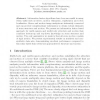113
click to vote
CVPR
2012
IEEE
12 years 10 months ago
2012
IEEE
Many architectural scenes contain symmetric or repeated structures, which can generate erroneous image correspondences during structure from motion (Sfm) computation. Prior work h...
ICCV
2011
IEEE
13 years 8 months ago
2011
IEEE
We present an approach to 3D scene flow estimation, which exploits that in realistic scenarios image motion is frequently dominated by observer motion and independent, but rigid ...
IJRR
2011
14 years 3 months ago
2011
Visual and inertial sensors, in combination, are able to provide accurate motion estimates and are well-suited for use in many robot navigation tasks. However, correct data fusion...
BMVC
2002
14 years 10 months ago
2002
Bundle adjustment is one of the cornerstone to recover the scene structure from a sequence of images. The main drawback of this technique, due to nonlinear optimisation, is the ne...
ICMCS
1999
IEEE
15 years 13 days ago
1999
IEEE
Abstract-- We describe a method to completely automatically recover 3D scene structure together with a camera for each frame from a sequence of images acquired by an unknown camera...
CVPR
2000
IEEE
15 years 17 days ago
2000
IEEE
Corners and curves are important image features in many vision-based applications. Corners are usually more stable and easier to match than curves,while curves contain richer info...
CVPR
2010
IEEE
15 years 20 days ago
2010
IEEE
Learning the knowledge of scene structure and tracking a large number of targets are both active topics of computer vision in recent years, which plays a crucial role in surveilla...
CVPR
2003
IEEE
15 years 1 months ago
2003
IEEE
A framework for analyzing distortions in non-single viewpoint imaging systems is presented. Such systems possess loci of viewpoints called caustics. In general, perspective (or un...
ACCV
2007
Springer
15 years 2 months ago
2007
Springer
Information fusion algorithms have been successful in many vision tasks such as stereo, motion estimation, registration and robot localization. Stereo and motion image analysis are...
ECCV
2002
Springer
15 years 10 months ago
2002
Springer
We consider dynamic scenes consisting of moving points whose motion is constrained to happen in one of a pencil of planes. This is for example the case when rigid objects move ind...

